| ← back |
Colonial Meetinghouses Featured in this Project |
next → |
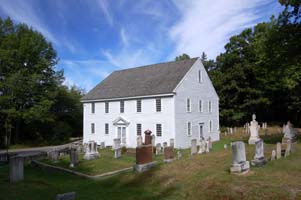 Name of Meetinghouse: Harrington Meeting House
Name of Meetinghouse: Harrington Meeting House
View on a mapStreet Address of Meetinghouse: 278 Harrington Rd., Pemaquid, MEYear(s) Built: 1775 National Register of Historic Places Designation: yes - 1970 Maine State Register of Historic Places: ? Organization responsible: Pemaquid Historical Association Organization's address: c/o Margo Hope, 239 Harrington Rd., Pemaquid, ME 04558 Organization's web site: none Town Information: Bristol, Maine (Pemaquid is a village within the town of Bristol) Tax status: Tax Exempt 501(c)(3) Contact: Margo Hope, 239 Harrington Rd., Pemaquid, ME 04558 Telephone: (207) 677-2193 E-mail: none This page was last modified on: Jul 18, 2013 Acknowledgements: The following text has been taken in part from the pamphlet Harrington Meeting House, written by C. Weston Dash, published by the Pemaquid Historical Association, and has been used by permission.
Col. David Dunbar, Surveyor of His Majesty's Woods in America,
In 1765 the settlements petitioned the General Court of Massachusetts (the district of Maine was then a part of Massachusetts) to form a town to be called Bristol, after the English city from which many of the early settlers came. The bounds were clarified in 1766 to include the present towns of Bristol, South Bristol, Bremen, and part of Nobleboro known as Damariscotta.
Such a large town needed more than one meetinghouse to care for
the religious and other needs of the population,
Harrington got off to a poor start.
Although the land was given in 1768 by William Sproul
on which the present meetinghouse is located,
a faction at what is now Bristol Mills determined that
the new meetinghouse should be erected there,
and a "post and beam" framework was erected on what is now
SR 130 opposite the present Seaside Grange.
However a subsequent Town Meeting finally authorized the framework
to be taken down and re-erected on Sproul's land
During the years from 1772 until 1778, Rev. Alexander McLain, a Presbyterian minister who came to this country in 1770, served the three parishes of Harrington, Walpole, and Greenland Cove, residing at Round Pond, and making his Sunday circuit by horseback preaching at least at two of them each week. The Walpole and Harrington meetinghouses (the latter now restored) still exist as they were constructed, however the one at Greenland Cove, located on what is now Old Shore Road, was taken down in the early 19th century and the materials were used to erect the present Union Church located in Bremen, on SR 32.
The last known use of the Harrington meetinghouse in its former condition was in 1915 when a funeral was held there.
In 1960 when Lincoln County was observing its 200th anniversary, Mrs. Ilonka Fertig, who lived across from and just south of the meetinghouse on Old Harrington Road, and was a trustee of the Lincoln County Cultural and Historical Association, decided at last to repair and make "habitable" the old meetinghouse.
When the first layer of plaster was removed from the walls, they discovered "graffiti" dating to the original building. and someone had written "McLain is a lying fool" (probably referring to the original preacher!). They found that there had been originally twenty eight windows and new doorways on one side had been put in instead of the old doors on three sides. From this Mrs. Fertig and Mr. Benner decided that this was not a second structure but the original.
She had been accepting contributions when the Internal Revenue Service office in Augusta, Maine, called her in to explain the deductions of contributions which had been noted. She explained the project in detail, and the investigating agent asked her if this was the only way she had of raising the funds.
As the meetinghouse was restored on a pay-as-you-go basis, the final price tag was approximately $50,000.
All of the box pews have been restored, the sawed-off bottom of the pulpit was restored
(carved by John Upton),
Governance of the Pemaquid Historical Association is vested in a body of directors elected annually, and administrative officers, president, vice-president, secretery, and treasurer. There are more than a hundred members of the Association, many of whom are now Life Members.
The building is available during the summer from June through September for special meetings,
concerts, and for weddings,
with a gift to the Association anticipated.
|

|

|
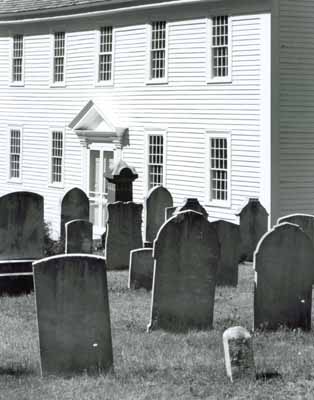
|
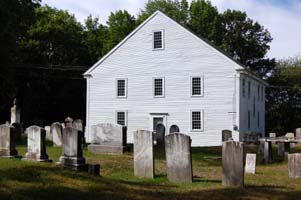 came to the Pemaquid region in 1729 to resettle the area
after the rout and destruction of Fort William Henry in 1696.
He brought 200 Irish Protestants, intending to rebuild the Fort
which he renamed Fort Frederick.
He divided the region into three basic settlements:
Walpole, Harrington, and Pemaquid.
came to the Pemaquid region in 1729 to resettle the area
after the rout and destruction of Fort William Henry in 1696.
He brought 200 Irish Protestants, intending to rebuild the Fort
which he renamed Fort Frederick.
He divided the region into three basic settlements:
Walpole, Harrington, and Pemaquid.
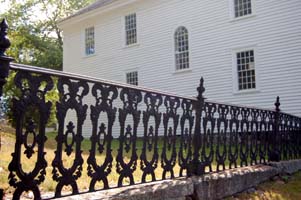 and, after much deliberation in town meetings between 1766 and 1772,
it was finally determined that at least three meetinghouses were required:
one in Harrington to take care of the Pemaquid and South Bristol regions,
one at Walpole to take care of the northwestern section of the town,
and one at Greenland Cove in what is now Bremen,
to take care of the northeastern section
including Round Pond.
and, after much deliberation in town meetings between 1766 and 1772,
it was finally determined that at least three meetinghouses were required:
one in Harrington to take care of the Pemaquid and South Bristol regions,
one at Walpole to take care of the northwestern section of the town,
and one at Greenland Cove in what is now Bremen,
to take care of the northeastern section
including Round Pond.
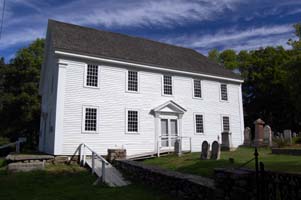 at the junction of two old roads located a bit east of
where the meetinghouse now stands,
in back of the present cemetery.
The three meetinghouses were completed by 1775 and accepted by the town of Bristol.
at the junction of two old roads located a bit east of
where the meetinghouse now stands,
in back of the present cemetery.
The three meetinghouses were completed by 1775 and accepted by the town of Bristol.
 About 1851, the Harrington meetinghouse became a Universalist Church,
and suffered its first physical changes.
It was jacked up and physically moved
over the top of the present cemetery
(without disturbing any of the stones).
The galleries were removed, as were the old box pews,
and the high pulpit was sawed off and lowered,
with a false ceiling and bench pews installed.
Also, it became apparent in later restoration,
that not only the doors were relocated,
but most of the windows also!
About 1851, the Harrington meetinghouse became a Universalist Church,
and suffered its first physical changes.
It was jacked up and physically moved
over the top of the present cemetery
(without disturbing any of the stones).
The galleries were removed, as were the old box pews,
and the high pulpit was sawed off and lowered,
with a false ceiling and bench pews installed.
Also, it became apparent in later restoration,
that not only the doors were relocated,
but most of the windows also!
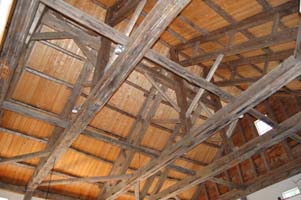 Thereafter, the roof was allowed to deteriorate,
permitting rain and moisture to crumble the interior plaster.
Bees took up residence in the combing under the roof,
having such a proliferation that the local beekeeper was able to
draw off substantial quantities of honey from the combs each year!
Thereafter, the roof was allowed to deteriorate,
permitting rain and moisture to crumble the interior plaster.
Bees took up residence in the combing under the roof,
having such a proliferation that the local beekeeper was able to
draw off substantial quantities of honey from the combs each year!
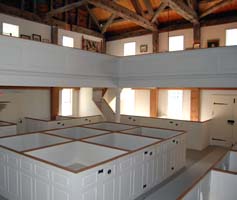 In Dr. John Johnson's "History of Bristol, Bremen, and the Pemaquid Settlement"
[1873, reprinted in 1973 and 1988 by the Bremen Library Association]
he indicated that the original meetinghouse had been destroyed
(as well as that at Greenland Cove)
when moved from Bristol Mills to William Sproul's land at Harrington.
Hence Mrs. Fertig was initially only interested in repairs to the building by putting on a new
roof and remodeling what remained of the crumbling plaster.
She engaged J. Carroll Benner of New Harbor as the contractor for the repairs.
In Dr. John Johnson's "History of Bristol, Bremen, and the Pemaquid Settlement"
[1873, reprinted in 1973 and 1988 by the Bremen Library Association]
he indicated that the original meetinghouse had been destroyed
(as well as that at Greenland Cove)
when moved from Bristol Mills to William Sproul's land at Harrington.
Hence Mrs. Fertig was initially only interested in repairs to the building by putting on a new
roof and remodeling what remained of the crumbling plaster.
She engaged J. Carroll Benner of New Harbor as the contractor for the repairs.
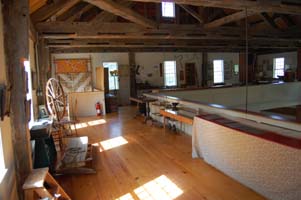 Restoration work was undertaken as Mrs. Fertig canvassed
friends, neighbors, and many others to provide the necessary funds for the restoration.
In true New England manner she refused to authorize any work for which funds were not then available!
She refused to consider any state or federal financial assistance,
determining that it would only entail more red tape and government interference!
Restoration work was undertaken as Mrs. Fertig canvassed
friends, neighbors, and many others to provide the necessary funds for the restoration.
In true New England manner she refused to authorize any work for which funds were not then available!
She refused to consider any state or federal financial assistance,
determining that it would only entail more red tape and government interference!
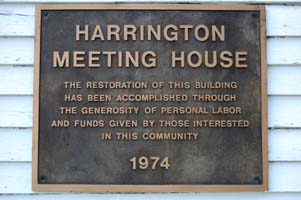 In true form, as only Ilonka Fertig could,
"I am too old to raise the money by any other means!!"
It was suggested that she should form a nonprofit organization,
apply for tax exemption,
which she and the late Carroll M. Hanna,
one of the town selectmen, did,
organizing the Pemaquid Historical Association,
which today provides funds for the maintenance and operation of the Harrington Meeting House,
while the actual ownership remains vested in the Town of Bristol.
In true form, as only Ilonka Fertig could,
"I am too old to raise the money by any other means!!"
It was suggested that she should form a nonprofit organization,
apply for tax exemption,
which she and the late Carroll M. Hanna,
one of the town selectmen, did,
organizing the Pemaquid Historical Association,
which today provides funds for the maintenance and operation of the Harrington Meeting House,
while the actual ownership remains vested in the Town of Bristol.
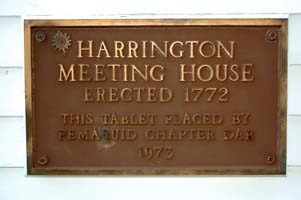 and the galleries restored,
but left without the original pews
so that they now house a magnificent historical museum of artifacts,
photos, tools, period clothing, instruments, maps, and documents,
to which local residents are continually adding exhibits.
and the galleries restored,
but left without the original pews
so that they now house a magnificent historical museum of artifacts,
photos, tools, period clothing, instruments, maps, and documents,
to which local residents are continually adding exhibits.
 For information on arrangements, address the Pemaquid Historical Association,
Pemaquid, ME 04558.
There is no charge for entrance to the building or the museum,
however a donation is appreciated.
During July and August it is generally open to the public on Monday,
Wednesday, and Friday afternoons from 2 until 4:30 PM,
with volunteer docents in charge.
Other arrangements for visits may be made by contacting
the Association well in advance of your projected visit.
For information on arrangements, address the Pemaquid Historical Association,
Pemaquid, ME 04558.
There is no charge for entrance to the building or the museum,
however a donation is appreciated.
During July and August it is generally open to the public on Monday,
Wednesday, and Friday afternoons from 2 until 4:30 PM,
with volunteer docents in charge.
Other arrangements for visits may be made by contacting
the Association well in advance of your projected visit.